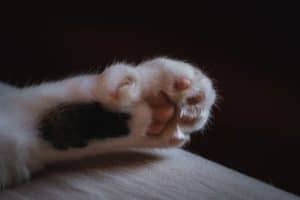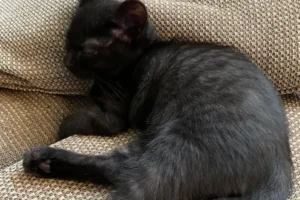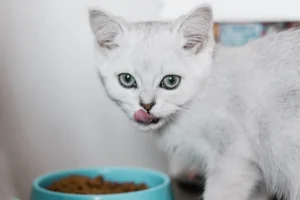Cats are fascinating creatures with many unique features, one of which is their ever-changing paw pads. Have you ever noticed how a cat’s paw pads can vary in color? It’s a curious phenomenon that has many cat owners wondering why this happens.
Cat paw pads change color due to a combination of genetics, age, and environmental factors.
Genetics Play a Role
Have you ever wondered why some cats have pink paw pads while others have black ones? Genetics play a significant role in determining the color of a cat’s paw pads. Just like how genes determine a cat’s fur color, they also influence the color of their paw pads.
A cat’s paw pad color is determined by the amount of pigment-producing cells called melanocytes present in their skin. Feline genetics dictate the distribution and activity of these cells, ultimately leading to different paw pad colors. For example, cats with white fur often have pink paw pads due to a lack of melanin, while cats with darker fur typically have black paw pads due to higher melanin levels.
If you’ve ever noticed a change in your cat’s paw pad color, it could be a result of genetic factors at play. While genetics lay the foundation for a cat’s paw pad color, other factors like age can also contribute to variations in color.
Age Matters
As your furry feline companion ages, you may start to notice changes in the color of their paw pads. Age can be a significant factor in determining the color of a cat’s paw pads.
Just like humans, cats undergo physiological changes as they grow older. These changes can also affect the pigmentation of their paw pads. As a cat ages, the melanocytes in their skin may become less active, leading to a fading or lightening of their paw pad color. This gradual change in pigmentation is a natural part of the aging process for many cats.
If you observe a shift in your cat’s paw pad color as they get older, don’t be alarmed. It’s simply a natural phenomenon that occurs with age. However, if you notice any drastic or sudden changes in color, it’s always a good idea to consult with your veterinarian to rule out any underlying health issues.
Remember, a cat’s paw pad color can be influenced by a variety of factors, with genetics and age playing key roles in determining their unique coloration. Just like us, our feline friends experience changes as they grow older, and these changes can manifest in surprising ways, such as alterations in their paw pad color.
Environmental Factors
Cat’s paw pads can change color due to various environmental factors. For example, exposure to sunlight can cause the pads to darken over time. Just like human skin, cat paw pads can develop a tan in response to sun exposure. Similarly, extreme temperatures can also play a role in changing the color of paw pads. Cold weather may cause the pads to become paler, while warm weather can lead to a darker hue. Additionally, the type of flooring a cat walks on regularly can impact their paw pad color. Rough surfaces may cause more friction, leading to calloused pads that appear darker in color.
Mood Indicators
Believe it or not, a cat’s paw pad color can sometimes be a reflection of their mood. When a cat is relaxed and content, their paw pads may appear a healthy pink color. On the other hand, if a cat is feeling stressed or anxious, their paw pads might appear paler than usual. Keep an eye on your furry friend’s paw pad color, as subtle changes could indicate shifts in their emotional state. Remember, just like humans, cats can show their feelings in various ways, and their paw pads are one subtle indicator worth paying attention to.
Additional Insight: Cats with lighter fur colors may have paw pads that are naturally pale in color. This is due to genetics and should not be a cause for concern.
Remember, understanding why your cat’s paw pads change color can help you better care for your feline friend. Keep an eye on these subtle changes, and remember that a healthy cat is a happy cat!
Health Concerns
Changes in a cat’s paw pad color can sometimes indicate underlying health issues. If you notice a sudden change in color, it’s essential to pay attention and consult with a veterinarian. Discoloration could be a sign of anemia, liver disease, or even a circulation problem. Keeping a close eye on your cat’s paw pads can help catch potential health concerns early and ensure prompt treatment if needed. Monitoring your cat’s paw pad color is a simple way to stay on top of their overall health.
Fun Facts About Cat Paw Pads
Did you know that a cat’s paw pads are unique and individual, much like human fingerprints? Each cat has its own distinct pattern on its paw pads, making them truly one of a kind. Next time you look at your feline friend’s paws, take a moment to appreciate their one-of-a-kind markings.
Tips for Paw Pad Care
Caring for your cat’s paw pads is essential to maintaining their health and vibrancy. To keep your feline friend’s paw pads in top condition, follow these simple tips:
Regular Check-ups: Make it a habit to inspect your cat’s paw pads regularly for any signs of irritation, cuts, or dryness. Early detection of issues can prevent more serious problems down the road.
Moisturize: Just like humans, cats can benefit from moisturizing their paw pads. Look for pet-safe moisturizers specifically designed for paw pads to keep them soft and supple.
Trim Claws: Long claws can affect the way your cat walks, leading to pressure on their paw pads. Keep your cat’s claws trimmed to reduce this pressure and prevent discomfort.
Avoid Harsh Surfaces: Try to limit your cat’s exposure to rough or hot surfaces that can damage their sensitive paw pads. Provide soft bedding and safe outdoor areas for play.
Nutritious Diet: A balanced diet rich in essential nutrients can help maintain your cat’s overall health, including their paw pads. Consult your vet for recommendations on the best food for your furry friend.
Regular Exercise: Encourage your cat to stay active to promote healthy circulation in their paw pads. Toys and playtime can help keep your cat’s paws strong and flexible.
Consult a Vet: If you notice any changes in your cat’s paw pads, such as discoloration or swelling, consult your veterinarian for proper diagnosis and treatment.
Remember, taking good care of your cat’s paw pads is a simple way to show your love and ensure their comfort and well-being.
For more information on paw pad care, check out this resource from the American Association of Feline Practitioners: AAFP Paw Pad Health Guide
Alex, a passionate animal lover, has experience in training and understanding animal behavior. As a proud pet parent to two dogs and three cats, he founded AnimalReport.net to share insights from animal experts and expand his knowledge of the animal kingdom.




